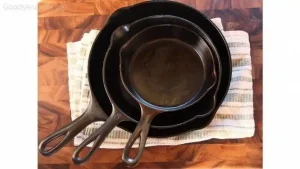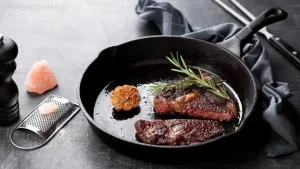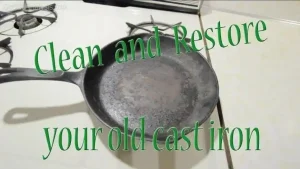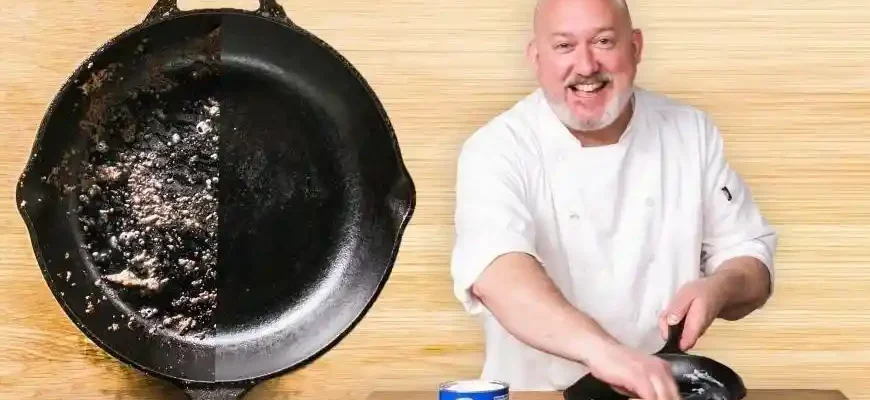Cleaning a cast iron skillet can seem like a mysterious ritual to some, but for those of us who’ve spent years cooking and caring for these timeless kitchen tools, it’s second nature. If you’ve just started using one, don’t worry! I’m here to share everything you need to know about cast iron care, from the basics to the more nuanced methods, with a few tricks up my sleeve. Trust me, after reading this, you’ll feel like a seasoned pro—and maybe even enjoy the process.
Why Clean a Cast Iron Skillet Properly?
Before diving into the cleaning methods, let’s talk about why it’s so important to clean your cast iron skillet properly in the first place.
Cast iron is unique because it improves with use—think of it as a fine wine that gets better with age. The seasoning (the thin layer of oil baked onto the surface) is what gives it its non-stick properties, enhances its flavor, and prevents rust. Cleaning it improperly can damage that seasoning or cause rusting, leading to a sad, rusty skillet that may need to be re-seasoned from scratch.
But not to worry—I’ll walk you through the right ways to clean and maintain it, no stress.
Step-by-Step Guide to Cleaning Your Cast Iron Skillet
1. While the Skillet is Still Warm:
Start cleaning your skillet right after use, while it’s still warm but not scorching hot. Don’t let it cool down too much. Warm cast iron is easier to clean, and the food remnants haven’t hardened yet.
2. Scrape Off Food:
Use a spatula or a non-metallic scraper to remove any big chunks of food. This is the first step—don’t skip it, or you’ll be scrubbing for hours.
3. Rinse with Water:
Unlike most pans, cast iron can handle water (within reason), so rinse it with warm water. If there’s stuck-on food, use a soft brush (like a dish brush or a chainmail scrubber) to scrub it off. If you don’t have one of those fancy scrubbing tools, you can also use a non-abrasive sponge.
4. Use Minimal Soap (Optional):
There’s a long-standing debate about whether soap is allowed in cast iron cleaning. The short answer is: a little soap is okay. Just don’t overdo it. A tiny drop of mild soap can help, but if you don’t have to use it, don’t. Soap can break down the seasoning layer, so be cautious with it. Generally, if your skillet isn’t sticky or grimy, water alone will do the trick.

5. Dry Thoroughly:
This is the most important step. If you leave water in your skillet, it will rust. To prevent this, dry the skillet immediately with a towel or paper towel. For extra insurance, you can place the skillet on low heat for a few minutes to ensure all moisture evaporates.
6. Re-oil the Skillet:
Once your skillet is dry, it’s time to maintain that beautiful seasoning layer. Use a paper towel or a cloth to rub a thin layer of oil onto the surface. You can use vegetable oil, flaxseed oil, or even bacon grease—whatever you’ve got on hand. Be sure to rub it in evenly and wipe away any excess. Too much oil can make the surface sticky.
7. Store Properly:
When storing your cast iron, place a paper towel inside to absorb any moisture and prevent rust. This is especially important if you live in a humid environment.
Special Considerations: What Not to Do
It’s all about balance when cleaning a cast iron skillet. Overdo it on the soap, let moisture linger, or scrub too aggressively, and you risk damaging that seasoning layer you’ve worked so hard to build. Here are some common mistakes to avoid:
- Don’t Soak the Skillet: Cast iron should never be left soaking in water for long periods. The water can seep into tiny cracks, leading to rust.
- Avoid Abrasive Scrubbing: Unless there’s something truly stubborn stuck on your skillet, avoid using harsh abrasives or metal pads that can scrape off the seasoning. Use chainmail scrubbers or coarse salt if necessary.
- Don’t Use It Like Nonstick Cookware: Cast iron needs some oil to prevent sticking. If you’re cooking something delicate (like eggs), make sure the skillet is well-seasoned and add enough oil or fat to the surface.

What If It Gets Rusty?
So, what happens if your skillet does rust? First of all, don’t panic! Rust happens, and it’s fixable. Simply scrub away the rust using a steel wool pad, then re-season your skillet by applying a thin layer of oil and baking it in the oven at 450°F for an hour (turn the skillet upside down on the middle rack, with a layer of foil on the rack below to catch any drips). This will restore your skillet to its former glory.
Additional Tips and Tricks
- Dealing with Stubborn Food: If your skillet is covered in caked-on food, try boiling water in it for a few minutes to loosen things up. Once it’s cool enough to handle, give it a good scrub.
- Re-seasoning After Cleaning: If you scrubbed too hard or used soap, don’t worry. Just re-season the skillet as you would when it’s brand new: apply a thin layer of oil and bake it at 450°F for an hour.
- Using Cast Iron Outdoors: If you take your skillet outdoors for grilling or camping, be sure to clean it thoroughly afterward. Sometimes, the heat can cause the seasoning to wear off, so a fresh oil rub after each use will help protect the surface.
Cast Iron Myths—Debunked!
A lot of misconceptions swirl around cast iron care. Let’s bust a few:
- Myth 1: Never Use Soap: As we discussed, a little bit of mild soap isn’t going to ruin your skillet. Just avoid going overboard.
- Myth 2: It’s Too Hard to Clean: If you clean your skillet while it’s still warm, it’s actually much easier. Don’t let stuck food dry on there—get to it while it’s fresh.
- Myth 3: You Can’t Cook Acidic Foods in Cast Iron: While it’s true that foods like tomatoes can strip away the seasoning if you cook them too often, it’s not the end of the world. Just make sure your skillet is well-seasoned and don’t cook acidic dishes every day.

Opinions from Around the World
Here’s what some folks from different backgrounds have to say about cast iron skillet care:
- John, 55, USA: “I’ve had my cast iron skillet for decades. I always clean it right after cooking—never let it soak in water. A quick scrub, a thin layer of oil, and it’s good as new. I use it every day, and I swear by it!”
- Yumi, 34, Japan: “I use my cast iron skillet for everything, from stir-fries to pancakes. The key is to always dry it thoroughly and re-season after each use. I love how it gets better with age.”
- Carlos, 42, Mexico: “Cast iron is great, but you have to care for it properly. I learned the hard way when I let mine rust. Now I make sure to oil it after every use, and it’s perfect.”
- Maya, 28, India: “In my family, we’ve been using cast iron for generations. My grandmother taught me that a little bit of soap isn’t the end of the world as long as you oil it well afterward.”
- Angela, 61, UK: “I’m old-school when it comes to cleaning cast iron. I don’t trust fancy cleaners or abrasives—just warm water and a good old cloth. It’s been with me for years, and I’ll never let it go.”
Final Thoughts
Caring for your cast iron skillet is really about balance—don’t overcomplicate it, but also don’t neglect it. With the right care, your skillet will last for generations and improve with age. Whether you’re a seasoned pro or just starting out, follow these tips and enjoy the process. Happy cooking!









